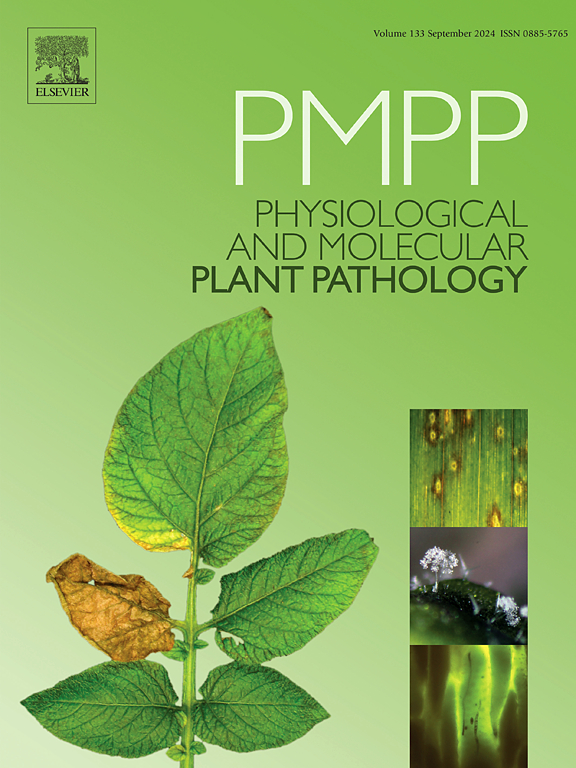Transcriptomic analyses of LtEpg1-and VvKINβ1-transgenic plants in response to Lasiodiplodia theobromae infection
IF 2.8
3区 农林科学
Q2 PLANT SCIENCES
引用次数: 0
Abstract
Botryosphaeria dieback, caused by the notorious pathogenic agent Lasiodiplodia theobromae, severely threatened the yield and quality of grapes globally. A comprehensive understanding of the fungal pathogenesis and plant defence will be of great importance to the development of efficient control measures. In previous publication, a secreted endopolygalacturonase LtEpg1 from L. theobromae was reported to interact with a SNF1-related protein kinase (SnRK) complex regulatory subunit VvKINβ1 from grapevine. Here, we ectopically expressed LtEpg1 and VvKINβ1 genes in Nicotiana benthamiana and profiled the transcriptome of LtEpg1-and VvKINβ1-transgenic lines. It was found that, after infection by L. theobromae, a total of 6676 and 4979 differentially expressed genes (DEGs) were identified in LtEpg1-and VvKINβ1-transgenic N. benthamiana, respectively, in comparison with wild type. The DEGs were involved in a wide range of physiological processes and immune responses, including photosynthesis, carotenoid biosynthesis, glycolysis, plant pathogen interaction, mitogen-activated protein kinase (MAPK) cascades, phytohormone signal transduction, and phenylpropanoid biosynthesis. Moreover, a total of 4990, 1212 and 4227 DEGs were identified in wild type, LtEpg1-and VvKINβ1-transgenic lines infected by L. theobromae, respectively, in comparison with the corresponding line grew under normal condition without inoculation. The DEGs were significantly enriched in photosynthesis and plant hormone signal transduction, suggesting relevant pathways were interrupted during infection. These results provide novel insights for exploring the molecular mechanisms of L. theobromae-grapevine interaction and supply valuable information for the genetic improvement of resistant grapevine in-depth.
ltepg1和vvkin β1转基因植株对可可枯病的转录组学分析
葡萄萎蔫病(Botryosphaeria dieback)是由葡萄枯病(Lasiodiplodia theobromae)引起的,严重威胁着全球葡萄的产量和品质。全面了解真菌的发病机制和植物防御对制定有效的防治措施具有重要意义。在之前发表的文章中,据报道,L. theobromae分泌的内聚半乳糖醛酸酶LtEpg1与葡萄藤中snf1相关蛋白激酶(SnRK)复合物调控亚基VvKINβ1相互作用。本研究在烟叶中异位表达了LtEpg1和VvKINβ1基因,并分析了LtEpg1和VvKINβ1转基因株系的转录组。结果发现,经可可乳杆菌侵染后,转ltepg1和转vvkin β1的benthamiana与野生型相比,分别鉴定出6676个和4979个差异表达基因。deg参与了广泛的生理过程和免疫反应,包括光合作用、类胡萝卜素生物合成、糖酵解、植物病原体相互作用、丝裂原活化蛋白激酶(MAPK)级联、植物激素信号转导和类苯丙烷生物合成。在野生型、ltepg1和vvkin β1转基因品系中分别鉴定出4990个、1212个和4227个deg,与正常条件下未接种的品系进行比较。deg在光合作用和植物激素信号转导中显著富集,表明相关途径在感染过程中被中断。这些结果为探索可可碱与葡萄相互作用的分子机制提供了新的见解,并为深入研究抗性葡萄的遗传改良提供了有价值的信息。
本文章由计算机程序翻译,如有差异,请以英文原文为准。
求助全文
约1分钟内获得全文
求助全文
来源期刊
CiteScore
4.30
自引率
7.40%
发文量
130
审稿时长
38 days
期刊介绍:
Physiological and Molecular Plant Pathology provides an International forum for original research papers, reviews, and commentaries on all aspects of the molecular biology, biochemistry, physiology, histology and cytology, genetics and evolution of plant-microbe interactions.
Papers on all kinds of infective pathogen, including viruses, prokaryotes, fungi, and nematodes, as well as mutualistic organisms such as Rhizobium and mycorrhyzal fungi, are acceptable as long as they have a bearing on the interaction between pathogen and plant.

 求助内容:
求助内容: 应助结果提醒方式:
应助结果提醒方式:


